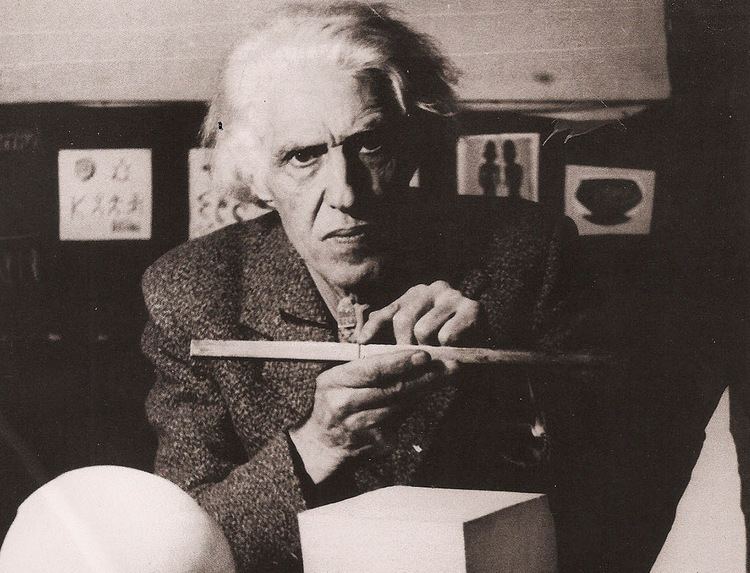 | ||
Nationality Uruguay Spanish Catalan Known for Painting, Sculpture, Writer, Teacher, Illustrator, Theorist Parents María García Pérez, Joaquim Torras Fradera Artwork Abstract Art in Five Tones an, Inverted America, Arte Universal, Constructive Composition, Figuras a Cinco Colores Similar Pedro Figari, Rafael Barradas, José Gurvich, Roberto Matta, Wifredo Lam | ||
El arte del uruguayo joaqu n torres garc a cautiva al moma en nueva york
Joaquín Torres García (28 July 1874 – 8 August 1949) also known as Joaquim Torras, Quim Torras was a Uruguayan/Catalan artist ("l'artista uruguaianocatalà Joaquim Torres Garcia"), painter, sculptor, muralist, novelist, writer, teacher and theorist who spent most of his adult life in Spain and France.
Contents
- El arte del uruguayo joaqu n torres garc a cautiva al moma en nueva york
- 18741900
- 19011909
- 19101919
- 19201922
- 19221924
- 1925
- 1933
- 19341949
- Poemes en ondes hertzianes 1919
- Selected Writings
- Selected paintings
- Murals
- Major exhibitions
- References
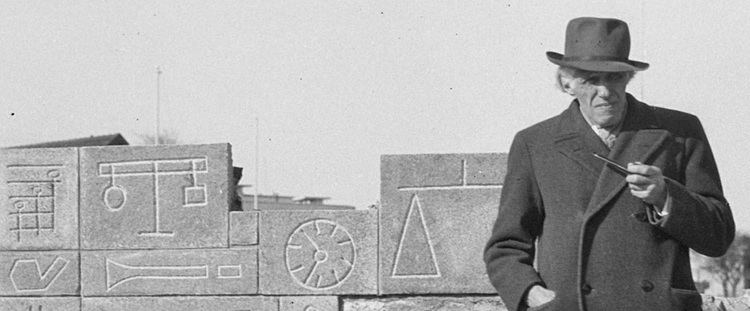
Eric Jardi termed him a "Uruguayan-Catalan artist, not only for being the son of a Mataronés but because he lived in Catalunya from the age of seventeen until he was forty-six, acquiring from the land of his father his strong artistic training, and dedicated to it an important sector of his work. He was one of the most notable personalities of artistic movement in the first half of the century.
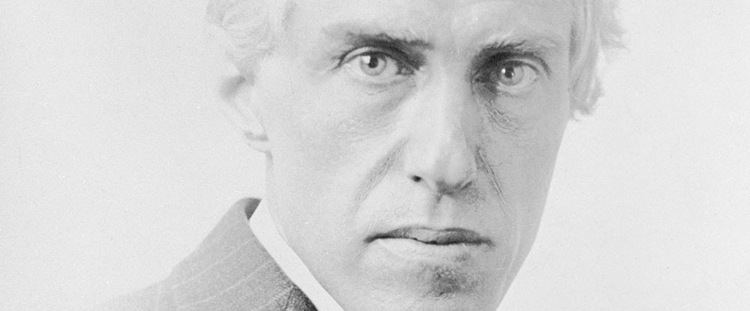
Pioneer of the renaissance of Modern Classicism, leader of the Mediterranean cultural tradition noucentisme, inventor of Universal Constructivism, "Torres-Garcia is one of the great figures of the art of this century", an avant gardist whose influence encompasses European, American and South American modern art.
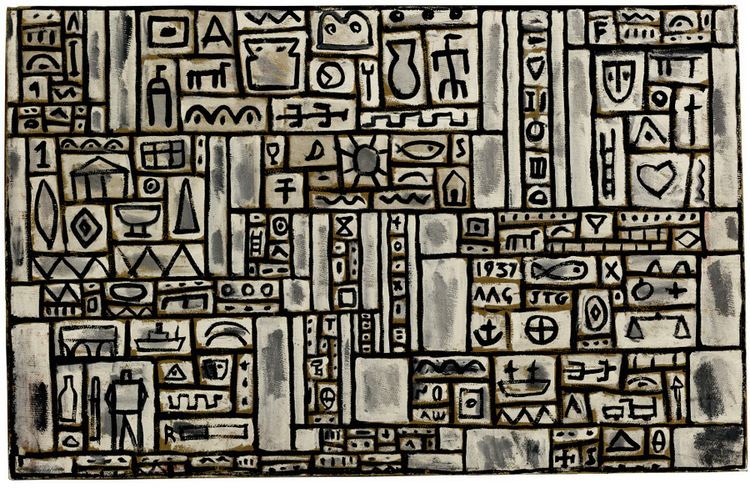
He is known for his collaboration with Gaudi in 1903 on the stained glass windows for the Palma Cathedral, and the Sagrada Família.
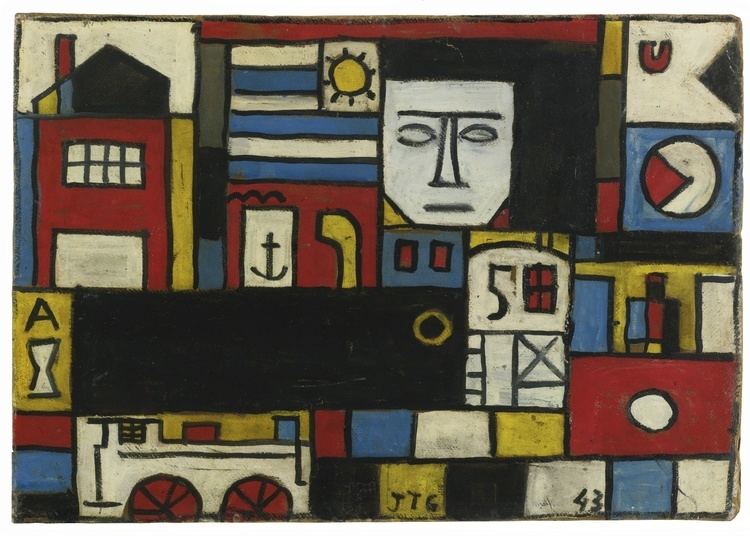
In 1913 he painted the famous monumental frescoes in the medieval Palau de la Generalitat seat of the Catalan government.
As a theoretician he published "more than one hundred and fifty books, essays and articles written in Catalan, Spanish, French, English; admirable treaties about aesthetics, calligraphy, pictograms and avant-garde literature.", and gave more than 500 lectures. An indefatigable teacher he founded two art schools one in Spain and another in Montevideo and numerous art groups including the first European abstract art group and magazine Cercle et Carré (Circle and square) in Paris in 1929. Many artists have called him "Maestro" (teacher) including Joan Miró, Helion, Pere Daura, Engel Rozier.
Retrospectives in Paris in 1955 and Amsterdam in 1961 are the earliest to document historically the place of Torres-Garcia in the currents of abstract art. In the United States he had important exhibitions in the 1920s, in the 1930s at Gallatin's Gallery of Living Art as a master of the European Modern Art among Arp, Braque, Gris, Picasso. Sidney Janis Gallery sponsored important shows from the 1950s. "In the United States he was probably underrated precisely because he was so influential; Adolph Gottlieb's and Louise Nevelson's debt to his work has never been fully acknowledged "
1874–1900
Joaquín Torres-García was born in Montevideo, Uruguay on 28 July 1874. He was the first child of Joaquim Torras Fradera (son of Joan Torras and Rosa Fradera), an emigrant from Mataró, Spain, and María García Pérez (daughter of José María García, from the Canary Islands, and Misia Rufina Pérez, Uruguayan). In 1861, Torres-García's father travelled in a brigantine to make his fortune in South America, and established a general store called the Almacen de Joaquín Torres. As a child, Torres "examined the picturesque store situated in the old Square of the Wagons, the arrival point of the raw material of the country for export to Europe. The colonial Montevideo had a port, trains, and a vibrant population dotted with countless gauchos wrapped in capes with whip ready in hand." "Much of his early education in that predominantly agricultural society came from his observation of the things around him ... He received his first formal art training when his family returned to Spain"
In 1891, Torres-García's father returned to Mataró, Spain, with his wife and three children. The family settled in Barcelona. Torres-García enrolled in the School of Fine Arts in Barcelona (Escuela de Bellas Artes de Barcelona), the Baixas Academy (Academia Baixas) and the Saint Lluc Artists Circle. "Torres-García and Picasso were contemporaries. Both began their artistic lives in modern Barcelona and although their artistic interests were diverse, they focused their attention on the representation of 'modern life' in both its typical and anecdotal aspects. This was a world of fashionable young ladies, prosperous bourgeoisie, Bohemian writers, picturesque actors, ragged and amusing artists and so on, whose privileged epicenter was the cafe Els Quatre Gats, an establishment maintained in the style of Parisian cabarets. The most appropriate medium in which to depict that world was the print, a drawing intended, in many cases, to be reproduced in the illustrated magazines of the time. The language came from Paris; the favorite models were Toulouse-Lautrec and Steinlen.". His classmates and friends included Ricard Canals, Manolo Hugue, Joaquim Mir, Isidre Nonell, Pablo Picasso, and Julio Gonzalez. Torres was an assiduous contributor of drawings in all the principal newspapers and magazines of the time, such as La Vanguardia, Iris, Barcelona Cómica and La Saeta.
In 1900, Torres Garcia's father died.
1901–1909
Miguel Utrillo wrote an article titled "Joaquin Torres-Garcia, Decorator" in Pel i Pluma, published with a portrait by Ramon Casas, photographs of several paintings by Torres — one on the cover of the magazine — and his first article, called "Impressions".
Antoni Gaudí commissioned Torres in 1903 to create stained-glass windows for Palma Cathedral. "One of the key events in his career was his intervention (between 1902 and 1905) in the High Altar of the Cathedral of Palma de Majorca, a masterpiece of Spanish Gothic, for which he made the lateral stained glass windows and the small rose window in the apse. His interpretation, of the Marian symbols carved in a stone placed above the cathedral's main entrance from the Song of Songs — in the words of Baltasar Coll Tomas — is one of the many dialogues proposed by Torres. Whereas approached from a symbolic/thematic perspective or from a universal stance, these symbols, along with the geometrical composition used by the medieval master masons, will be reinterpreted in every stage of Torres's long career: the sun, the moon, the star, the well, the garden, the tower, the temple. The spiritual realm, reason, feelings, the natural or earthly realm, immediate, intermediate, remote; past, present, future."
Eugeni d'Ors, the intellectual father (and inventor of the term) noucentisme, praised artworks that Torres Garcia shows at Sala Parés and the Cercle de Sant Lluc that same year. Later will write the prologue to Torres' show in the Galeries Dalmau in 1912 and includes frequent references of Torres's work in La Ben Plantada, the book which summarizes the ideology of the noucentista. But Torres is far from being an adherent of the ideology indicated by D'Ors; his evolution follows his own theoretical elaboration, explicit already in two texts published before the configuration of noucentisme as a trend around 1910: "Augusta et Augusta" (1904) and "La nostra ordinacio I el nostre cami" (1907). In Classicism, Torres searches for model of order, a language and an adequate cultural reference to overcome the realistic tendency of representation and to develop a Catalan art of capable of universal proportions. Objective which coincides with noucentisme, but Torres's radicalness paradoxically separate him from artists who follow this tendency — Sunyer, Canals, Aragay — and ultimately D'Ors.
Torres-García began teaching art in 1907 and "gradually became involved with an experimental school Colegio Mont d'Or founded by his friend the progressive educator Joan Palau Vera. Contrary to the academic expectations of the day, at Mount D'Or here were no copies from casts, prints or books; drawing went directly to reality: all the common objects of the house from the kitchen to the laboratory were paraded in front of students, as well as leaves, fruits, fish, flowers, animals. The vocabulary of universal constructivism was being developed as an exercise in progressive pedagogy."
In 1909, he married Manuela Piña i Rubíes, a Catalonian, with whom he would have four children.
1910–1919
Torres-García traveled to Brussels to paint a Pavilion in the Brussels International World Fair. During this prolonged stay in Paris, he visited friends, museums and galleries. Though different, his art shared values with cubism and the theories exemplified in the exhibition organized and named by Jacques Villon in honor of Luca Paccioli, Section d'Or (Golden Section); an exhibition first shown in Paris.
On his first trip to Italy and Switzerland, Torres-García observed the ancient and the modern: futurism.
In 1911 he exhibited in the VI International Exhibition of Art in Barcelona the iconic painting "X Musa" which he donated by request of Prat de la Riba to the Institut d'Estudis Catalans were it still is today. "From the moment of its public appearance until today this work has been unanimously interpreted by the historiography as the foundational reference of noucentisme."
In May 1913, he published his first book, Notes sobre Art (Notes on Art). In the introduction he writes "Aquestes curtes notes poden tenir interès, demes, per anar estretament lligades, com quelcom de viu, a tot o que arrencant de la nostra tradició, en el pensament i en la realitat, tendeix a formar el ver Renaixement e Catalunya" (These short essays may be of interest also because they are closely related to, something that is alive, sprung from our tradition, in thought and in reality, to form the true Renaissance of Catalonia). Founded the Escuela de Decoración (School of Decoration/Decorative Arts) in Sarrià. "Prat de la Riba had then his newly formulated conception of Catalan nationalism, and sees in the Mediterranean tradition proposed a positive content for the national profile, rich in spiritual substance. Prat de la Riba protects the painter and commissions the famous frescoes of the Deputation."
In 1913 he began to create murals for the decoration of the monumental atrium of the Municipal Palace of Barcelona. "Today the work of the Palace of the Generalitat of Catalonia is fortunately preserved faithfully in its most substantial core to its original architecture. It was not, however, until 1907, when Enric Prat de la Riba became chairman of the council, which began an important period dedicated to exalt building, parallel to the resurgence of the national political structure. ... Also began a series of mural paintings at the Salon Sant Jordi, an important work by the Uruguayan Catalàn artist Joaquim Torres-Garcia, remaining unfinished at the death of Prat de la Riba in 1917, going beyond the utilitarian and decorative to become the new symbol of the Catalonia noucentista."
"For the next five years, he planned and executed murals in fresco technique, employing an "Iconostasis" composition, applied to a "pagan" subject matter and then to a modern theme, proving that classic is not solely associated to the Greek. He painted with orthogonal lines the rhythms of the structure used. This was an evolution he described in "El Descubrimiento de si mismo", and in the manifesto "Evolucionista" published in 1916. Torres-García would later use this same composition in his "Constructivist" works." He designed, built, and decorated with frescoes his home in Tarrasa, "Mon Repos".
In 1918 "Torres-Garcia can be seen exploring the grid structure,' on the one hand as an inherent characteristic of a modern city and on the other as a form to explore the symbolic potential of everyday motifs. He also explored the potential for language within images, as in the 1916–17 drawing 'Discovery of Oneself'."
In 1919, he was dismissed by Josep Puig i Cadafalch, the new president of the Mancomunitat who prevented him from continuing the great work decoration Saló de Sant Jordi, in the old Palau de la Generalitat, Torres-Garcia sold the house he had designed and built in Terrassa in 1914, Mon Repos, and left his second homeland. "he determined to take the pulse of the greatest and most modern of cities, New York."
1920–1922
Departs a second time for Paris, with thirty-two crates of paintings. After an encounter with his friend Picasso, his work turns to cubism, while Picasso's to classicism. Seeking to experience a modern city, he travels to New York. Paints a series of portraits, including one of Joseph Stella. The vertical city enhances the orthogonal structure of his cityscape. Works at painting scenery and costumes of The Great Way, a story of the joyful, the sorrowful, the glorious. Exhibits at The Whitney Studio Gallery and The Society of Independent Artists together with Stuart Davis and Szukalski. Dada art all over again. He described his work as "... what painting Torres-García created at that time? ..." he asks himself: "... expressionistic and geometric at the same time, and very dynamic"
1922–1924
Returns to Italy. Further development of his Classic and Evolutionistic works. Spain forbids Catalan language, among which Torres- Garcia's writings are included. Death of his mother. Travels to France, Villefranche-sur-Mer.
1925
Moves to Paris for the third time. Exhibits 34 works, a series of large classical nudes and paintings from New York at Galerie A. G. Fabre. " Forty works make up this presentation of Torres-Garcia first exhibit here at Galerie Fabre: frescoes, fragments of large murals, assembled architectural maquettes , still life or figures ...They show the artist under different aspects manifesting all the fiery wealth and complex diversity. Some urban landscapes will give an idea of the passage of Torres-Garcia by New York were feverish spectacle of the business city captivated some time his artistic inquietude in search of its rhythm. Although he has played a major role in the development of the Mediterranean school, Garcia is bent with such a force towards his personal inclination he has always cleared away from the prejudices of isms (schools) that might limit his personal growth" "However, by returning to the Classicism of his early work he made it clear that this was not an artistic language he had sought to vanquish through abstraction", in June. Solo exhibit at Galerie Zak in December 1928. Group exhibition in Galerie des Editions Bonaparte with John Graham, Kakabadze, Tutundjian, and Vantongerloo in August 1929. Solo exhibit in Galerie Carmine. A correspondent for the Catalan literary magazine Mirador, writes series of articles on painters including an interview of Georges Braque. In 1931 he has two solo exhibits at Galerie Jeanne Bucher and Galerie Percier, in October a group show at Georges Petit with Giacometti, Ozenfant, Max Ernst, Miro, Salvador Dalí . In 1932 a solo exhibit at Galerie Pierre of paintings and sculptures. "The friendship between Van Doesburg and Torres-Garcia will create the foundations for the three most important movements to promote abstract art: "Cercle et Carre" (1929–1930), "Art Concret" (1930); and "Abstraction-Creation"(1931–1936)." ".. he founded the magazine Cercle et Carre with Theo Van Doesburg, and with many difficulties assembled a group of 80 artists who exhibited in No. 23 rue de la Boetie. "
1933
Leaves for Madrid. Finishes the manuscript of "Arte Constructivo" published in 1935 with under the name "Estructura", dedicated to his friend Piet Mondrian. Teaches and lectures.
1934–1949
1934 At sixty returns for the first time since childhood to Montevideo. Exhibits the work of the "Cercle et Carre" group and reedits the magazine as "Circulo y Cuadrado". As he did in Barcelona he now shapes the artistic education of Uruguay, Argentina, Brazil and Chile. He creates the "Taller Torres Garcia", similar to the European Bauhaus. This school included future artists like Gonzalo Fonseca, José Gurvich, Alceu Ribeiro, Julio Alpuy and Torres García's sons, Horacio and Augusto Torres, among others. Builds the "Monumento Cosmico" and paints mural frescoes at the Hospital Saint Bois. Paints a series of portraits under the name of "Men, Heroes and Monsters ".
1949 Dies 8 August while preparing two exhibitions one at Sidney Janis Gallery in New York and other at Pan American Union in Washington.
The Joaquín Torres García Hall in the Palace of the Generalitat of Catalonia houses the frescoes the artist painted in the walls of Salon Sant Jordi in the years 1912–1916, commissioned by the President of the Council and the Commonwealth of Catalonia, Enric Prat de la Riba.
"Actual work on the first mural began on his birthday, July 28. It lasted 13 days precisely in the 13th year of the century. It was unveiled on September 13."
After the death of Prat de la Riba, his patron, the superb examples of modern classicism, the monumental murals created by Torres-Garcia for the Palace of the Generalitat in the Hall of St. George, iconic symbols of the previous government, will be interrupted first, then threatened by Joan Vallès i Pujals, new president of the council, and finally "destroyed" (covered with other paintings). Recovered in 1966, are currently displayed in another room of the Palace Hall called Torres-García.
Poemes en ondes hertzianes 1919
Illustrations by Joaquin Torres-Garcia.
